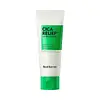What's inside
What's inside
 Key Ingredients
Key Ingredients

 Benefits
Benefits

 Concerns
Concerns

 Ingredients Side-by-side
Ingredients Side-by-side

Water
Skin ConditioningPropanediol
SolventNiacinamide
SmoothingPanthenol
Skin ConditioningCetearyl Alcohol
EmollientButylene Glycol
Humectant1,2-Hexanediol
Skin ConditioningSqualane
EmollientTriethyl Citrate
MaskingCetyl Ethylhexanoate
EmollientCentella Asiatica Extract
CleansingAsiaticoside
AntioxidantAsiatic Acid
Skin ConditioningMadecassic Acid
Skin ConditioningGlyceryl Stearate Citrate
EmollientGlyceryl Stearate
EmollientDiisostearyl Malate
EmollientHydroxyethyl Acrylate/Sodium Acryloyldimethyl Taurate Copolymer
Emulsion StabilisingAcrylates/C10-30 Alkyl Acrylate Crosspolymer
Emulsion StabilisingTromethamine
BufferingHydroxyacetophenone
AntioxidantLecithin
EmollientDisodium EDTA
Adenosine
Skin ConditioningSorbitan Isostearate
EmulsifyingMelia Azadirachta Leaf Extract
Skin ConditioningMelia Azadirachta Flower Extract
Skin ConditioningDipotassium Glycyrrhizate
HumectantMyristoyl/Palmitoyl Oxostearamide/Arachamide Mea
Skin ConditioningArginine
MaskingWater, Propanediol, Niacinamide, Panthenol, Cetearyl Alcohol, Butylene Glycol, 1,2-Hexanediol, Squalane, Triethyl Citrate, Cetyl Ethylhexanoate, Centella Asiatica Extract, Asiaticoside, Asiatic Acid, Madecassic Acid, Glyceryl Stearate Citrate, Glyceryl Stearate, Diisostearyl Malate, Hydroxyethyl Acrylate/Sodium Acryloyldimethyl Taurate Copolymer, Acrylates/C10-30 Alkyl Acrylate Crosspolymer, Tromethamine, Hydroxyacetophenone, Lecithin, Disodium EDTA, Adenosine, Sorbitan Isostearate, Melia Azadirachta Leaf Extract, Melia Azadirachta Flower Extract, Dipotassium Glycyrrhizate, Myristoyl/Palmitoyl Oxostearamide/Arachamide Mea, Arginine
Water
Skin ConditioningHelianthus Annuus Seed Oil
EmollientGlycerin
HumectantSimmondsia Chinensis Seed Oil
EmollientC14-22 Alcohols
Emulsion StabilisingCetearyl Alcohol
Emollient1,2-Hexanediol
Skin ConditioningEthylhexyl Palmitate
EmollientCoco-Glucoside
CleansingGlyceryl Stearate
EmollientC12-20 Alkyl Glucoside
EmulsifyingMyristoyl/Palmitoyl Oxostearamide/Arachamide Mea
Skin ConditioningCeramide NP
Skin ConditioningCaprylyl Glycol
EmollientXanthan Gum
EmulsifyingCitrus Aurantium Bergamia Fruit Oil
MaskingPanthenol
Skin ConditioningBrassica Oleracea Italica Sprout Extract
EmollientCitrus Limon Peel Oil
MaskingSodium Phytate
Carbomer
Emulsion StabilisingTriticum Vulgare Sprout Extract
Skin ConditioningSpirulina Platensis Extract
Skin ProtectingCitric Acid
BufferingAllantoin
Skin ConditioningCentella Asiatica Extract
CleansingCedrus Atlantica Bark Oil
MaskingLavandula Angustifolia Oil
MaskingPelargonium Graveolens Flower Oil
MaskingCananga Odorata Flower Oil
MaskingVetiveria Zizanoides Root Oil
MaskingMadecassoside
AntioxidantWater, Helianthus Annuus Seed Oil, Glycerin, Simmondsia Chinensis Seed Oil, C14-22 Alcohols, Cetearyl Alcohol, 1,2-Hexanediol, Ethylhexyl Palmitate, Coco-Glucoside, Glyceryl Stearate, C12-20 Alkyl Glucoside, Myristoyl/Palmitoyl Oxostearamide/Arachamide Mea, Ceramide NP, Caprylyl Glycol, Xanthan Gum, Citrus Aurantium Bergamia Fruit Oil, Panthenol, Brassica Oleracea Italica Sprout Extract, Citrus Limon Peel Oil, Sodium Phytate, Carbomer, Triticum Vulgare Sprout Extract, Spirulina Platensis Extract, Citric Acid, Allantoin, Centella Asiatica Extract, Cedrus Atlantica Bark Oil, Lavandula Angustifolia Oil, Pelargonium Graveolens Flower Oil, Cananga Odorata Flower Oil, Vetiveria Zizanoides Root Oil, Madecassoside
Ingredients Explained
These ingredients are found in both products.
Ingredients higher up in an ingredient list are typically present in a larger amount.
1,2-Hexanediol is a synthetic liquid and another multi-functional powerhouse.
It is a:
- Humectant, drawing moisture into the skin
- Emollient, helping to soften skin
- Solvent, dispersing and stabilizing formulas
- Preservative booster, enhancing the antimicrobial activity of other preservatives
Centella Asiatica Extract (Centella) is derived from an herb native to Southeast Asia. It is famous for its anti-inflammatory and soothing properties.
Centella is rich in antioxidants and amino acids, such as Madecassic Acid and Asiaticoside.
Studies show the compounds in centella help with:
The combination of all these properties makes centella effective at soothing, hydrating, and protecting the skin.
Other great components of centella include Vitamin A, vitamin C, several B vitamins, and Asiatic Acid.
Fun fact: Centella has been used as a medicine and in food for many centuries. As a medicine, it is used to treat burns, scratches, and wounds.
Learn more about Centella Asiatica ExtractCetearyl alcohol is a mixture of two fatty alcohols: cetyl alcohol and stearyl alcohol. It is mainly used as an emulsifier. Emulsifiers help prevent the separation of oils and products. Due to its composition, it can also be used to thicken a product or help create foam.
Cetearyl alcohol is an emollient. Emollients help soothe and hydrate the skin by trapping moisture.
Studies show Cetearyl alcohol is non-toxic and non-irritating. The FDA allows products labeled "alcohol-free" to have fatty alcohols.
This ingredient is usually derived from plant oils such as palm, vegetable, or coconut oils. There is debate on whether this ingredient will cause acne.
Due to the fatty acid base, this ingredient may not be Malassezia folliculitis safe.
Learn more about Cetearyl AlcoholGlyceryl Stearate is a mix of glycerin and stearic acid.
It is used to stabilize the mixing of water and oil ingredients. By preventing these ingredients from separating, it can help elongate shelf life. It can also help thicken the product's texture.
As an emollient, it helps soften skin and supports barrier-replenishing ingredients.
In cosmetics, Glyceryl Stearate is often made from vegetable oils or synthetically produced.
This ingredient may not be fungal-acne safe
Fun fact: The human body also creates Glyceryl Stearate naturally.
Learn more about Glyceryl StearateWe don't have a description for Myristoyl/Palmitoyl Oxostearamide/Arachamide Mea yet.
Panthenol is a common ingredient that helps hydrate and soothe the skin. It is found naturally in our skin and hair.
There are two forms of panthenol: D and L.
D-panthenol is also known as dexpanthenol. Most cosmetics use dexpanthenol or a mixture of D and L-panthenol.
Panthenol is famous due to its ability to go deeper into the skin's layers. Using this ingredient has numerous pros (and no cons):
Like hyaluronic acid, panthenol is a humectant. Humectants are able to bind and hold large amounts of water to keep skin hydrated.
This ingredient works well for wound healing. It works by increasing tissue in the wound and helps close open wounds.
Once oxidized, panthenol converts to pantothenic acid. Panthothenic acid is found in all living cells.
This ingredient is also referred to as pro-vitamin B5.
Learn more about PanthenolWater. It's the most common cosmetic ingredient of all. You'll usually see it at the top of ingredient lists, meaning that it makes up the largest part of the product.
So why is it so popular? Water most often acts as a solvent - this means that it helps dissolve other ingredients into the formulation.
You'll also recognize water as that liquid we all need to stay alive. If you see this, drink a glass of water. Stay hydrated!
Learn more about Water